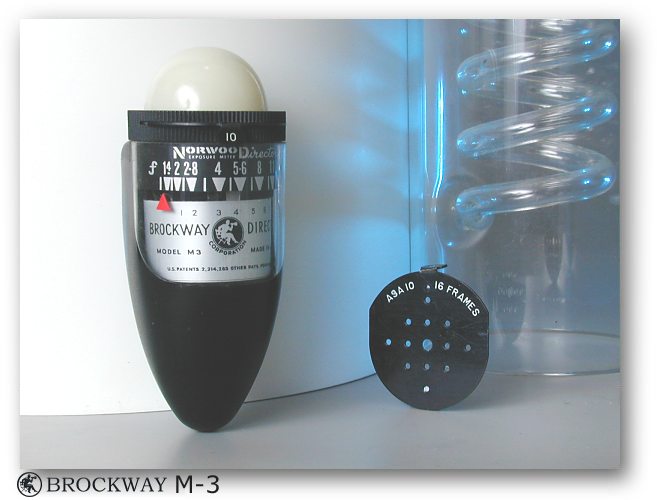 |
the BROCKWAY M-3. NORWOOD DIRECTOR Direct reading model! Quote:"As the old sing, so twitter the young'" |
 |

 Here is a drawing from the original patent of Don Norwood.
Here is a drawing from the original patent of Don Norwood.More can be found under the number: 2824696 -2214283 at the American Patents bureau. |

 Also the meter came with two slides, one is the same as the bright slide of the earlier models of Norwood Director, it has a direct reading value by 1/50 sec.(10 ASA). The other one is Asa12-1/30 sec (Cine).
Films are much faster these days so we have to compute...! There must be more slides available, so I'm looking for more, they have the same form as the Spectra slides (no corners but rounded instead)
Also the meter came with two slides, one is the same as the bright slide of the earlier models of Norwood Director, it has a direct reading value by 1/50 sec.(10 ASA). The other one is Asa12-1/30 sec (Cine).
Films are much faster these days so we have to compute...! There must be more slides available, so I'm looking for more, they have the same form as the Spectra slides (no corners but rounded instead)Anyhow, I'm working most of the time with a filmspeed of 100/125. It is not that hard to use mental calculation to find the combination for my film. With the slide in I can use the readout by 1/500sec.(100ASA) With the slide out in dull weather the shutterspeed is 1/15sec.(100ASA) See for other equivalents here. The Apertures on the scale are from f/1.4 - f/16 Note the numbers from 1-7, directly below the aperture scale, these are Polaroid numbers and could be used with the Slide marked P only! |
  To give you an idea of the meters size and how to hold it, my wife was so kind to demonstrate.
To give you an idea of the meters size and how to hold it, my wife was so kind to demonstrate.Please note the slide has been removed to show meter activity caused by the Studio lights! |
  My two Cents...
My two Cents...As a matter of fact it does not matter if the meter is some years of age, the results were right in those days, why should it not work for you and now? Of course there are modern solutions, digital meters with Silicon-blue cell scales to a tenth focus stop. What use? ,if we don't have an electronic shutter! Remember, even the dark-hat method works flawless...for experienced photographers with very old barrel-type lenses. Also a very modern combination with a little hardware (palmtop) and software from BTZS Just enter your variables and you will get the perfect exposure.( If you made a good interpretation that is) Sure it works, but it is still the man behind the machine that makes the difference! For those who want to get rid of Polaroid backs to check the exposure, there is the ultimate machine, a digital camera that works from very old photographic rules, you can now have spot metering, matrix and center-weight. If you like what you see, read the exposure/aperture combination at 100 ISO, recalculate to your film used in the casettes .....expose, et Voilą Now you have a Conventional and a Digital Image, you can even make a Hybride Image. Thanks for reading and have fun... |

|
Author
||| Foot-Candle TEST
||| History
||| Identification
||| Yesterday's Meters
||| HelioValve
||| Model M-3
||| M series
||| FaQ!!
||| Wanted!! ||| SlideShow ||| About slides ||| Condensed Manual Norwood ||| Condensed manual Brockway/Sekonic-S ||| Speed reading ||| Quiz ||| Impressum ||| Friends of ND ||| New Cell? ||| Where to buy ||| E-Mail ||| CD-ROM |


 |
 |
 |
 |
 |
 |
 |
 |







